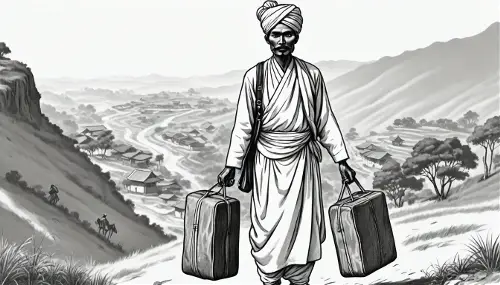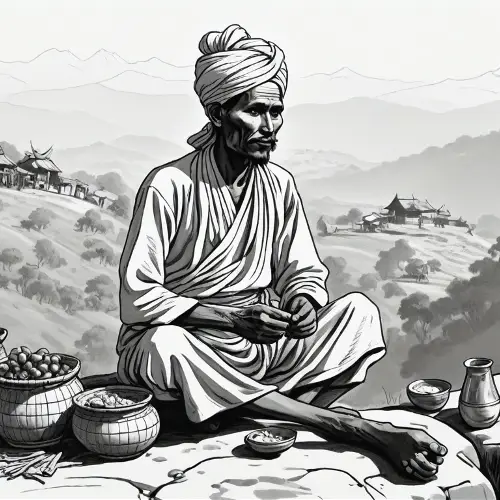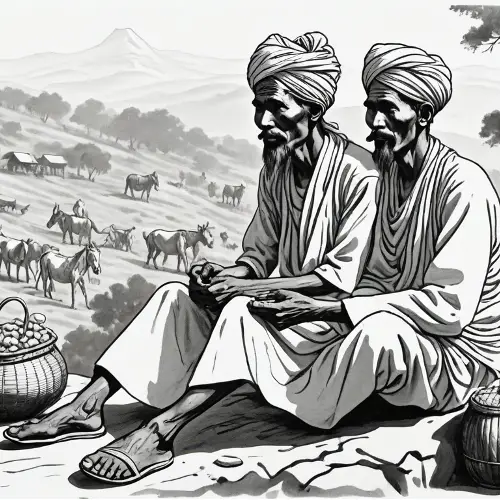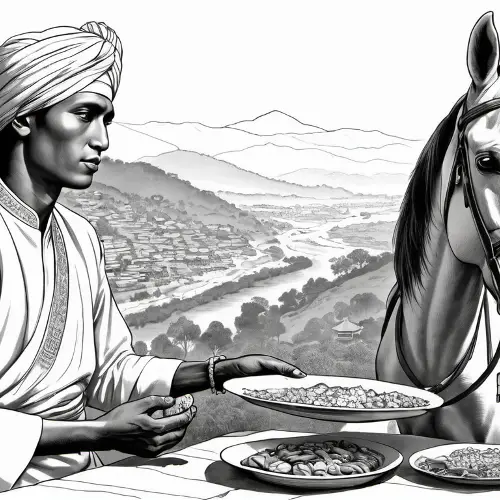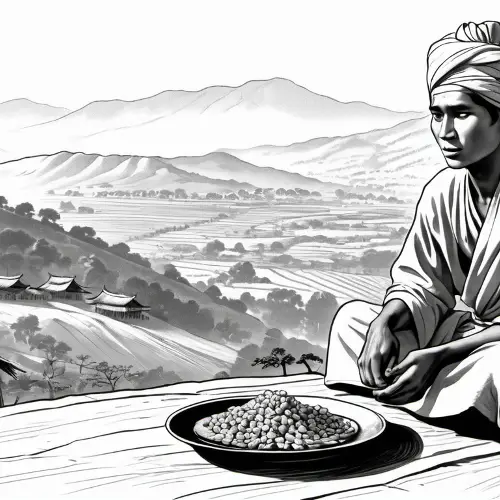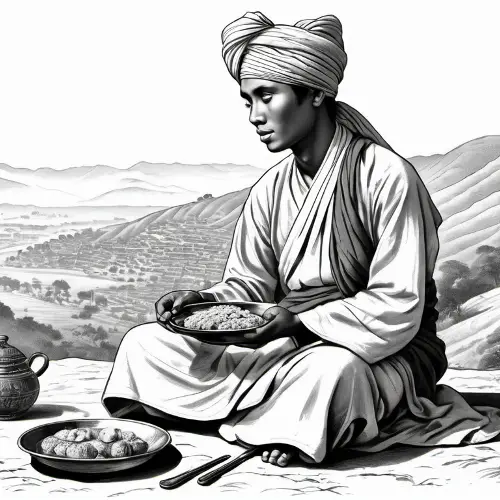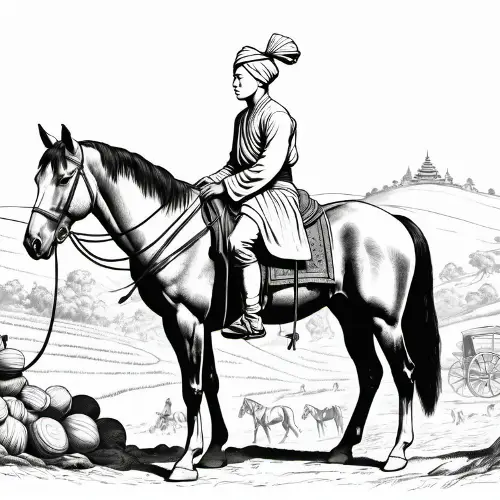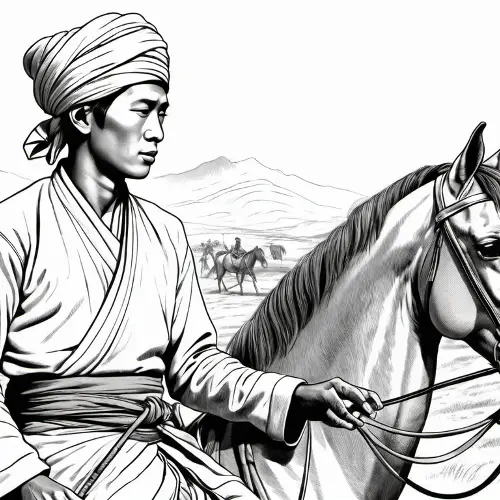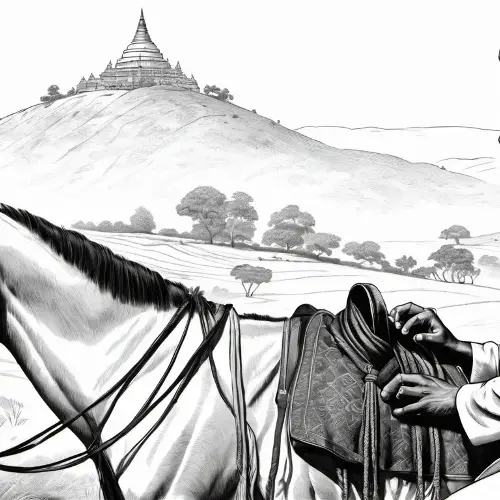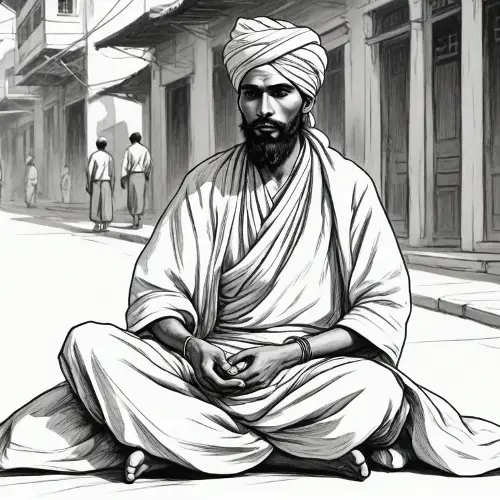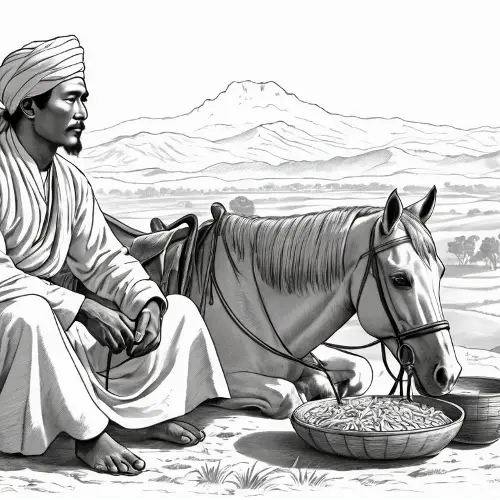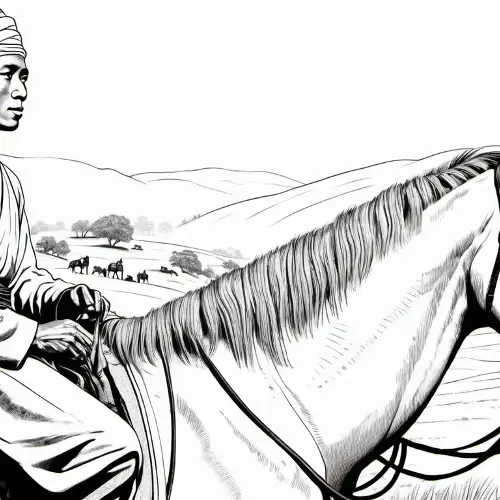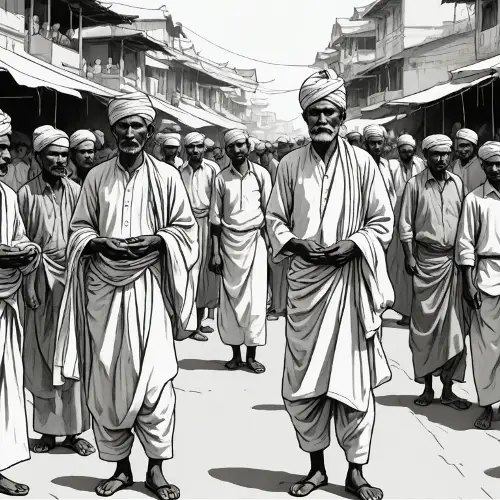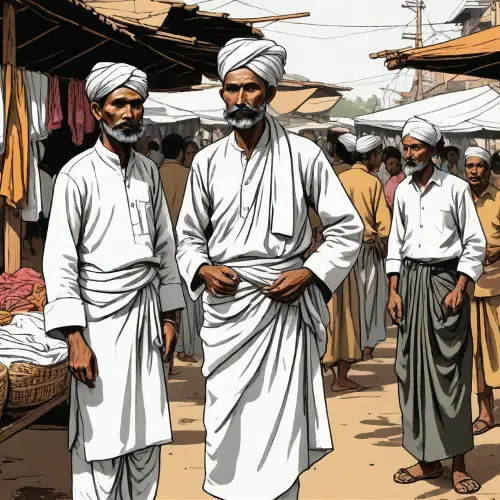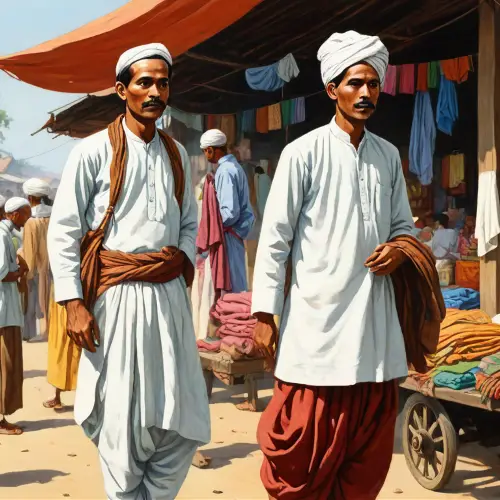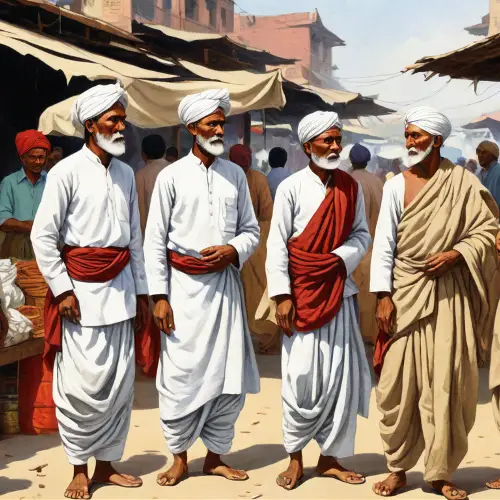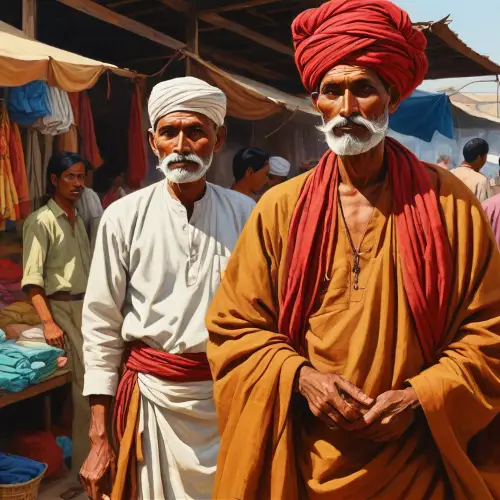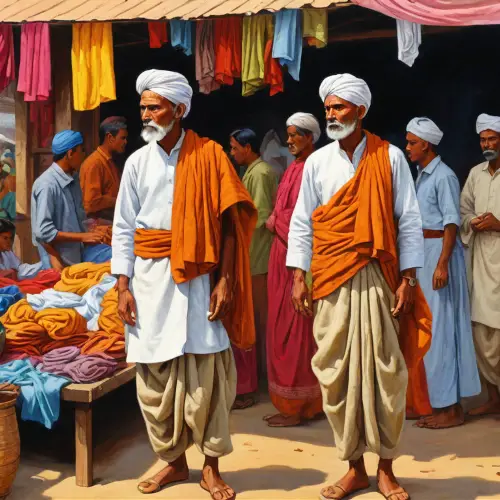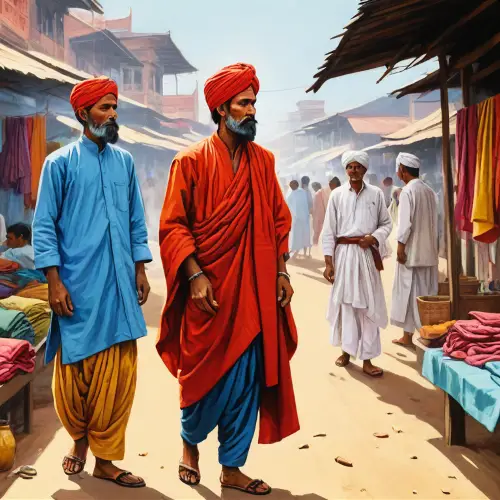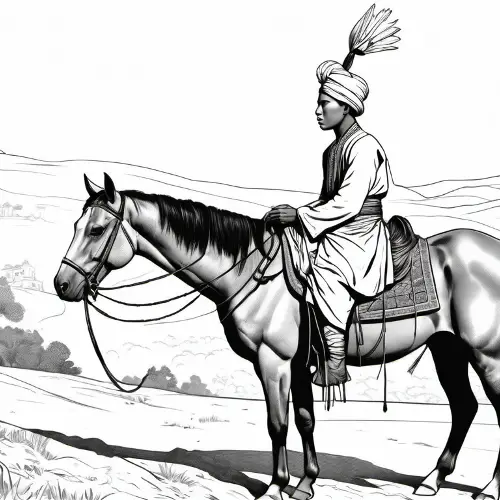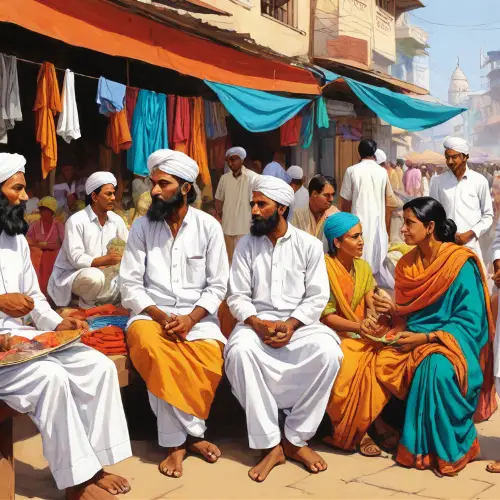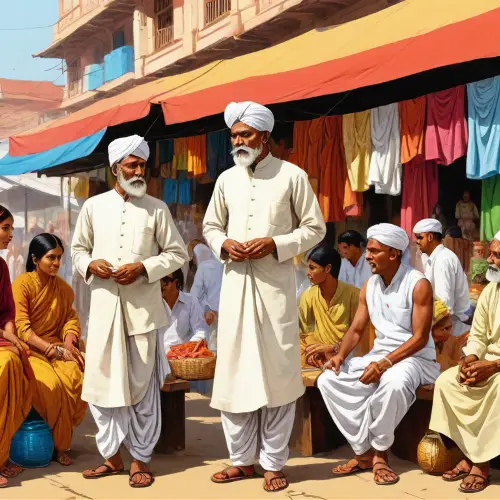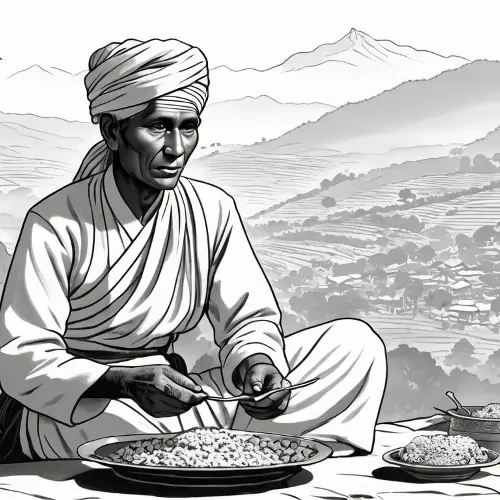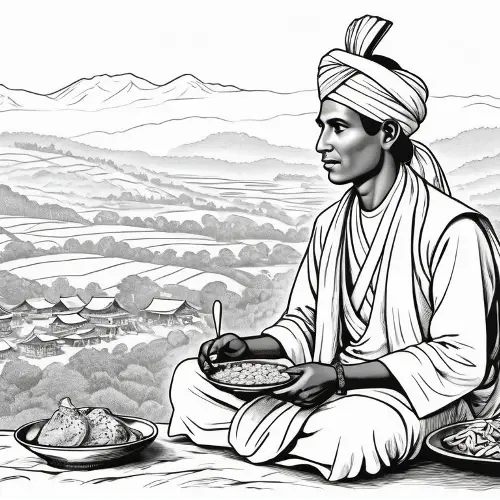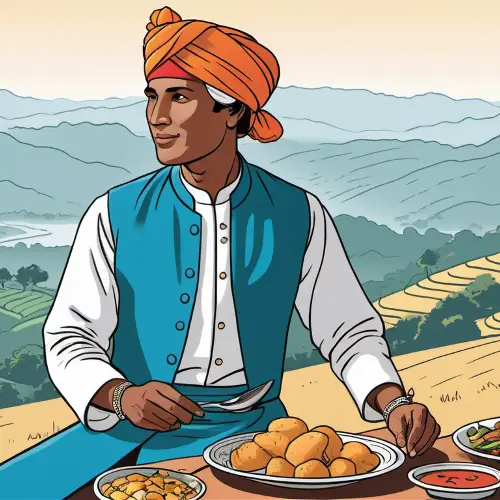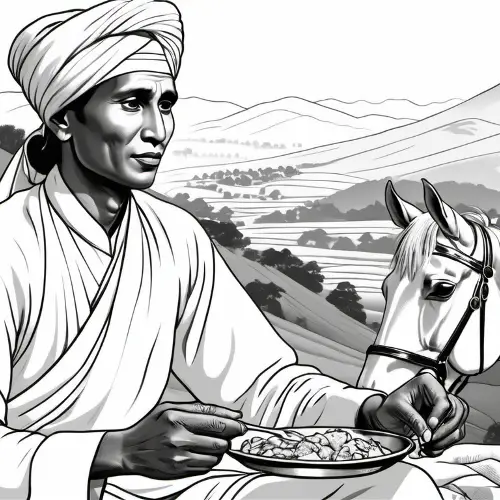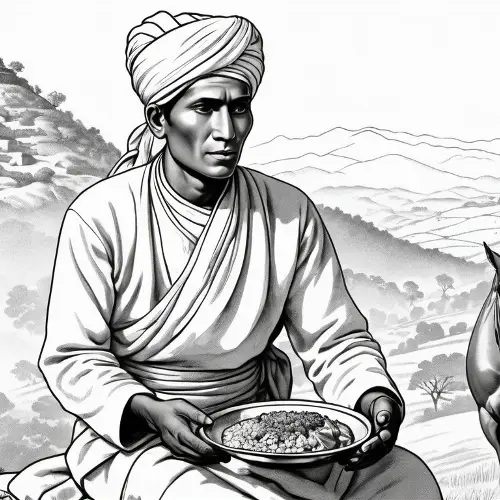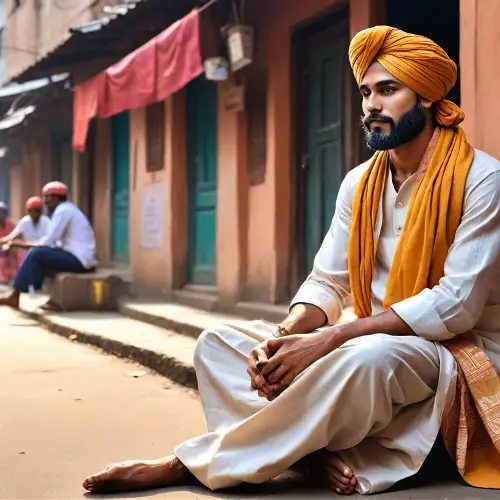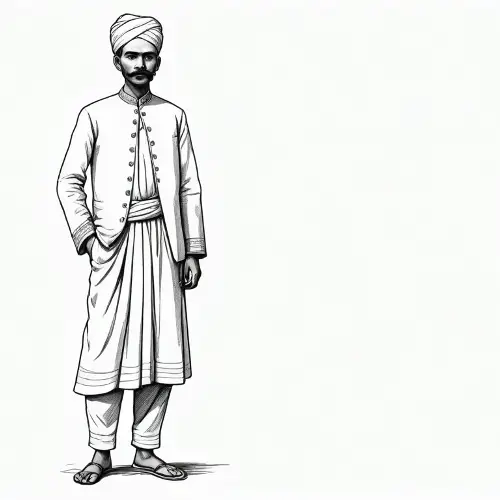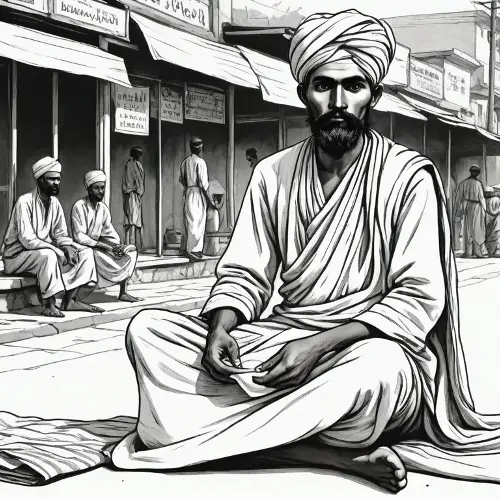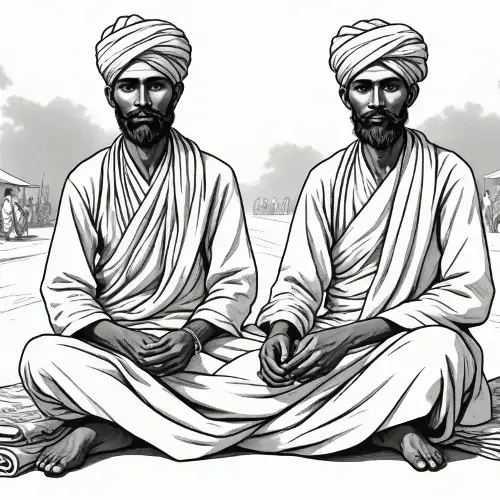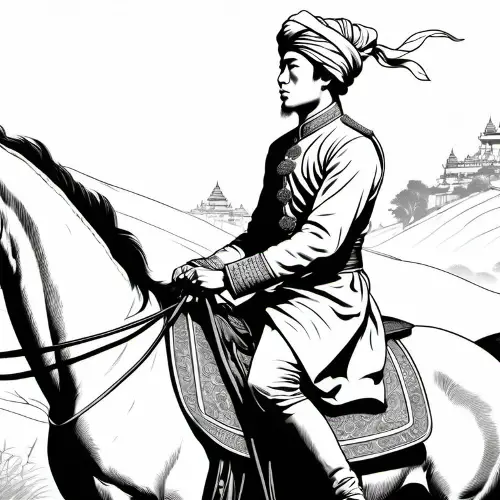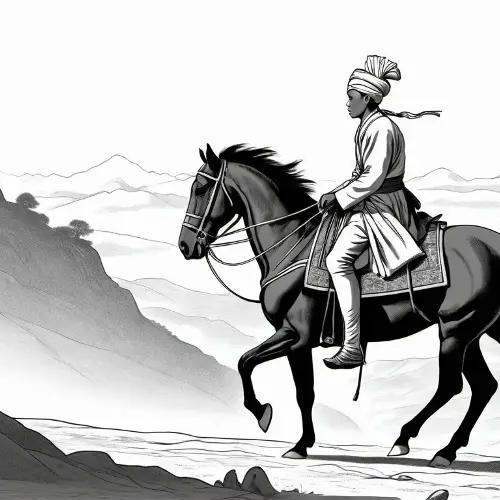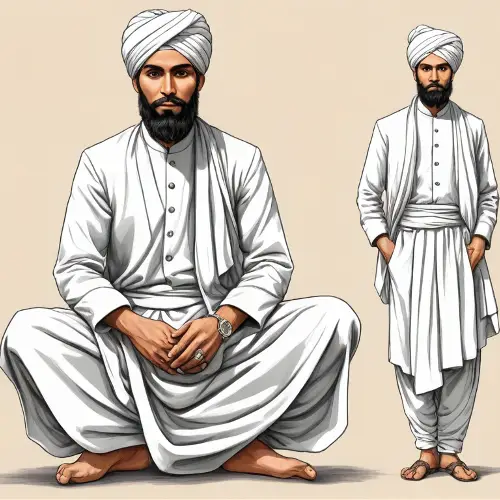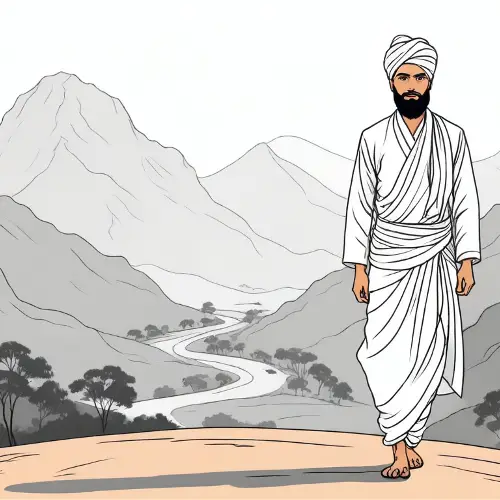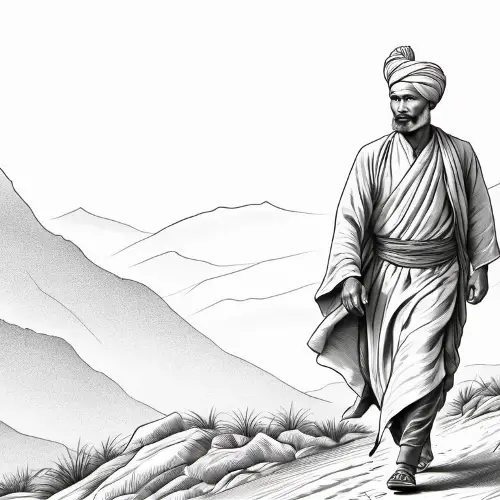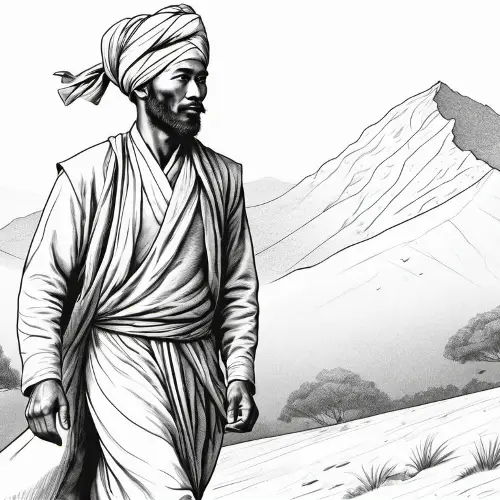Imagine a scene in the hill area of Burma in the year 1880. A distinguished man is depicted, wearing a traditional turban, kurta, and dhoti, standing with a sense of grace. His attire is detailed, reflecting the cultural nuances of the region during that period. Beside him, a mule is tethered, carrying goods or belongings, adding an element of daily life in the hills. The landscape around is hilly, with lush vegetation and perhaps a glimpse of distant mountains. The man may be holding a piece of luggage or engaged in an activity, further emphasizing the context of life in Burma during the late 19th century.
More Like This
Imagine a scene in the hill area of Burma in the year 1880. A distinguished man is depicted, wearing a traditional turban, kurta, and dhoti, standing with a sense of grace. His attire is detailed, reflecting the cultural nuances of the region during that period. Beside him, a mule is tethered, carrying goods or belongings, adding an element of daily life in the hills. The landscape around is hilly, with lush vegetation and perhaps a glimpse of distant mountains. The man may be holding a piece of luggage or engaged in an activity, further emphasizing the context of life in Burma during the late 19th century.
Imagine a scene in the hill area of Burma in the year 1880. A distinguished man is depicted, wearing a traditional turban, kurta, and dhoti, standing with a sense of grace. His attire is detailed, reflecting the cultural nuances of the region during that period. Beside him, a mule is tethered, carrying goods or belongings, adding an element of daily life in the hills. The landscape around is hilly, with lush vegetation and perhaps a glimpse of distant mountains. The man may be holding a piece of luggage or engaged in an activity, further emphasizing the context of life in Burma during the late 19th century.
Imagine a scene in the hill area of Burma in the year 1880. A distinguished man is depicted, wearing a traditional turban, kurta, and dhoti, standing with a sense of grace. His attire is detailed, reflecting the cultural nuances of the region during that period. Beside him, a mule is tethered. The landscape around is hilly, with lush vegetation and perhaps a glimpse of distant mountains. The man may be holding a piece of luggage or engaged in an activity, further emphasizing the context of life in Burma during the late 19th century.
Imagine an Indian man in the hilly region of Burma in 1880. Hes sitting on a rock or a simple surface, wearing a turban and a traditional doti. The man is depicted enjoying a meal in a serene setting. Beside him, a mule is securely tied, and luggage is neatly arranged, indicating a moment of rest during a journey. The hilly landscape features rugged terrains with greenery and perhaps a glimpse of a winding trail or distant hills. This scene captures a peaceful moment in the daily life of an individual in the hill areas of Burma during the late 19th century.
Imagine an Indian man in the hilly region of Burma in 1880. Hes sitting on a rock or a simple surface, wearing a MARWADI THIN turban and a traditional doti. The man is depicted enjoying a meal in a serene setting. Beside him, a mule is securely tied, and luggage is neatly arranged, indicating a moment of rest during a journey. The hilly landscape features rugged terrains with greenery and perhaps a glimpse of a winding trail or distant hills. This scene captures a peaceful moment in the daily life of an individual in the hill areas of Burma during the late 19th century.
Envision a scene in the hilly terrain of Burma in the year 1880. A man, adorned in a turban and traditional doti, is seated on a rock or a makeshift surface, savoring a meal. His attire is intricately detailed, reflecting the cultural identity of the region during that period. Beside him, a mule is securely tied, and luggage is neatly arranged nearby, suggesting a pause in a journey or a moment of rest during travel. The hilly backdrop features rugged landscapes, with vegetation and perhaps a glimpse of a winding trail or distant hills. The scene captures a serene moment in the daily life of Burmas hill areas in the late 19th century
Generate vivid and historically accurate images depicting an Indian man, donned in a turban, savoring a meal next to his tied horse in the picturesque hills of Myanmar in the year 1837. Capture the cross-cultural tableau, emphasizing the traditional Indian attire against the backdrop of the Myanmar landscape. Pay meticulous attention to historical details, including the intricate design of the turban, clothing styles, and the scenic beauty of the hills. Convey the cultural richness and tranquility of the moment as the man enjoys his meal beside his horse in the historical context of Myanmar in 1837
Generate captivating and historically accurate images depicting a man with a turban immersed in the act of eating his food amidst the serene hills of Myanmar in the year 1837. Portray the cultural richness by highlighting the traditional Indian turban and attire against the backdrop of the Myanmar landscape. Pay meticulous attention to historical details, including the mans clothing style, the picturesque hills, and the tied horse nearby. Convey the tranquil and cross-cultural ambiance of the moment, providing a visual narrative of daily life in the Myanmar hills during the 19th century.
Generate evocative and historically accurate images depicting a man wearing a turban peacefully eating in the serene hills of Myanmar in the year 1837, with his horse tied nearby. Capture the tranquility of the moment, emphasizing the cultural significance of the turban, the traditional attire, and the picturesque Myanmar hills. Pay meticulous attention to historical details, including clothing styles, landscape features, and the interaction between the man, his meal, and the tied horse. Convey the timeless connection between individuals, nature, and animals within the historical context of Myanmar in 1837
Generate evocative and historically accurate images depicting a indian man wearing a turban peacefully eating in the serene hills of Myanmar in the year 1837, with his horse tied nearby. Capture the tranquility of the moment, emphasizing the cultural significance of the turban, the traditional attire, and the picturesque Myanmar hills. Pay meticulous attention to historical details, including clothing styles, landscape features, and the interaction between the man, his meal, and the tied horse. Convey the timeless connection between individuals, nature, and animals within the historical context of Myanmar in 1837
LINE ART SKETCH OF MAN WEARING TURBAN DHOTI KURTA SEATING ON HALF SEATED POSITION ON STREET OF BURMA IN 1880
Generate evocative and historically accurate images depicting a man wearing a turban peacefully eating in the serene hills of Myanmar in the year 1837, with his horse tied nearby. Capture the tranquility of the moment, emphasizing the cultural significance of the turban, the traditional attire, and the picturesque Myanmar hills. Pay meticulous attention to historical details, including clothing styles, landscape features, and the interaction between the man, his meal, and the tied horse. Convey the timeless connection between individuals, nature, and animals within the historical context of Myanmar in 1837
Generate evocative and historically accurate images depicting a man wearing a turban peacefully eating in the serene hills of Myanmar in the year 1837, with his horse tied nearby. Capture the tranquility of the moment, emphasizing the cultural significance of the turban, the traditional attire, and the picturesque Myanmar hills. Pay meticulous attention to historical details, including clothing styles, landscape features, and the interaction between the man, his meal, and the tied horse. Convey the timeless connection between individuals, nature, and animals within the historical context of Myanmar in 1837
Create a sketch capturing the cultural fusion in a bustling market scene in Burma circa 1880. Focus on a Marwadi man, dressed in a traditional dhoti and kurta, actively engaged in selling cloth materials. The man could be showcasing vibrant textiles characteristic of Marwadi culture.
Create a sketch capturing the cultural fusion in a bustling market scene in Burma circa 1880. Focus on a Marwadi man, dressed in a traditional dhoti and kurta, actively engaged in selling cloth materials. The man could be showcasing vibrant textiles characteristic of Marwadi culture. Detail the merchants attire, paying attention to the intricacies of the dhoti and kurta, as well as any accessories that might signify his cultural background. Emphasize the array of fabrics and textiles displayed in his stall of the cloth trade during that era. Surround the Marwadi cloth merchant with the diverse sights of the market – other stalls, customers exploring, and perhaps fellow merchants. Incorporate architectural elements of the market, suggesting the traditional structures and ambiance of a Burmese market in the late 19th century
Create a sketch capturing the cultural fusion in a bustling market scene in Burma circa 1880. Focus on a Marwadi man, dressed in a traditional dhoti and kurta, actively engaged in selling cloth materials. The man could be showcasing vibrant textiles characteristic of Marwadi culture. Detail the merchants attire, paying attention to the intricacies of the dhoti and kurta, as well as any accessories that might signify his cultural background. Emphasize the array of fabrics and textiles displayed in his stall, depicting the rich colors and textures indicative of the cloth trade during that era. Surround the Marwadi cloth merchant with the diverse sights of the market – other stalls, customers exploring, and perhaps fellow merchants. Incorporate architectural elements of the market, suggesting the traditional structures and ambiance of a Burmese market in the late 19th century. Consider the play of light and shadow on the fabrics, creating depth and visual interest in the scene. Capture the expressions on the faces of the merchant and potential customers, conveying the lively interaction in this cultural exchange. In essence, aim to portray the dynamic cultural commerce as the Marwadi man brings the vibrancy of his textiles to the bustling marketplace of 1880 Burma.
Create a sketch capturing the cultural fusion in a bustling market scene in Burma circa 1880. Focus on a Marwadi man, dressed in a traditional dhoti and kurta, actively engaged in selling cloth materials. The man could be showcasing vibrant textiles characteristic of Marwadi culture. Detail the merchants attire, paying attention to the intricacies of the dhoti and kurta, as well as any accessories that might signify his cultural background. Emphasize the array of fabrics and textiles displayed in his stall, depicting the rich colors and textures indicative of the cloth trade during that era. Surround the Marwadi cloth merchant with the diverse sights of the market – other stalls, customers exploring, and perhaps fellow merchants. Incorporate architectural elements of the market, suggesting the traditional structures and ambiance of a Burmese market in the late 19th century. Consider the play of light and shadow on the fabrics, creating depth and visual interest in the scene. Capture the expressions on the faces of the merchant and potential customers, conveying the lively interaction in this cultural exchange. In essence, aim to portray the dynamic cultural commerce as the Marwadi man brings the vibrancy of his textiles to the bustling marketplace of 1880 Burma.
\Generate compelling and historically accurate images depicting an Indian man, adorned in a turban, peacefully eating in the scenic hills of Myanmar in the year 1837, with his horse tied nearby. Capture the cultural fusion of Indian attire against the backdrop of the Myanmar landscape, emphasizing the traditional elements of the turban, clothing, and the serene hills. Pay meticulous attention to historical details, including clothing styles, landscape features, and the harmonious interaction between the man, his meal, and the tied horse. Convey the cross-cultural essence of the moment within the historical context of Myanmar in 1837
Sketch a vibrant scene capturing the cultural dynamism of a Burmese market in 1880, with a focus on a Marwadi man wearing a traditional dhoti and kurta, actively engaged in selling cloth materials while seated. Surround the merchant with the lively atmosphere of the market, including other shops and people engaging in transactions. Detail the Marwadi mans attire with precision, showcasing the intricacies of the dhoti and kurta, and emphasize the array of cloth materials on display. Illustrate the surrounding market scene with architectural elements, such as nearby shops or stalls, and include a diverse group of people, some browsing and others engaged in purchasing textiles.
Generate immersive and historically accurate images portraying an Indian man, adorned with a turban, peacefully enjoying his meal in the scenic hills of Myanmar in the year 1837. Emphasize the cultural blend through the traditional Indian turban and attire against the backdrop of the Myanmar landscape. Pay meticulous attention to historical details, including clothing styles, the picturesque hills, and the horse tied nearby. Convey the harmonious and cross-cultural moment, illustrating the quietude of an individual relishing food in the tranquil beauty of the Myanmar hills during the 19th century.
Generate vivid and historically accurate images capturing an Indian man with a turban enjoying his food in the peaceful hills of Myanmar in 1837. Illustrate the cultural fusion through the traditional Indian turban and attire against the scenic backdrop of Myanmar. Pay meticulous attention to historical details, such as the mans clothing, the serene hills, and the horse positioned closely nearby. Convey the harmonious and cross-cultural ambiance of the moment, where the man, his food, and the horse coexist in the tranquil beauty of the Myanmar hills during the 19th century
Generate vivid and historically accurate images capturing an Indian man with a turban enjoying his food in the peaceful hills of Myanmar in 1837. Illustrate the cultural fusion through the traditional Indian turban and attire against the scenic backdrop of Myanmar. Pay meticulous attention to historical details, such as the mans clothing, the serene hills, and the horse positioned closely nearby. Convey the harmonious and cross-cultural ambiance of the moment, where the man, his food, and the horse coexist in the tranquil beauty of the Myanmar hills during the 19th century
Sketch a dreamlike scene where a Marwadi man, adorned in a turban, dhoti, and kurta, is seated on a quaint Burmese road, surrounded by an ethereal atmosphere. The focus is on the serene moment as he passionately sells cloth materials, creating a captivating blend of cultural richness and historical charm. Detail the Marwadi mans traditional attire, paying special attention to the flowing dhoti, intricately wrapped turban, and the details of his kurta.
Sketch a dreamlike scene where a Marwadi man, adorned in a turban, dhoti, and kurta, is seated on a quaint Burmese road, surrounded by an ethereal atmosphere. The focus is on the serene moment as he passionately sells cloth materials, creating a captivating blend of cultural richness and historical charm. Detail the Marwadi mans traditional attire, paying special attention to the flowing dhoti, intricately wrapped turban, and the details of his kurta.
marwadi man wearing dhoti and kurta selling clothes material burma in 1880
MARWADI MAN WEARING DHOTI KURTA AND TURBAN SEATING ON ROAD AND SELLING CLOTH MATERIAL IN BURMA IN 1885
Generate vivid and historically accurate images depicting a man with a turban riding a horse against the wind amidst the scenic hills of Myanmar in the year 1830. Capture the dynamic interaction between the rider, his turban billowing in the wind, and the challenging terrain of the hills. Pay meticulous attention to period-specific clothing, horse tack, and cultural elements, ensuring an authentic representation of the time. Convey the spirit of adventure and resilience as the rider navigates the rugged beauty of the Myanmar hills in the early 19th century
Generate vivid and historically accurate images depicting a man with a turban riding a horse against the wind amidst the scenic hills of Myanmar in the year 1830. Capture the dynamic interaction between the rider, his turban billowing in the wind, and the challenging terrain of the hills. Pay meticulous attention to period-specific clothing, horse tack, and cultural elements, ensuring an authentic representation of the time. Convey the spirit of adventure and resilience as the rider navigates the rugged beauty of the Myanmar hills in the early 19th century
bamboo shop roof Sketch a vibrant scene capturing the cultural dynamism of a Burmese market in 1880, with a focus on a Marwadi man wearing a traditional dhoti and kurta, actively engaged in selling cloth materials while seated. Surround the merchant with the lively atmosphere of the market, including other shops and people engaging in transactions. Detail the Marwadi mans attire with precision, showcasing the intricacies of the dhoti and kurta, and emphasize the array of cloth materials on display. Illustrate the surrounding market scene with architectural elements, such as nearby shops or stalls, and include a diverse group of people, some browsing and others engaged in purchasing textiles.
To create a line art sketch of a Marwadi man wearing a turban, dhoti, and kurta, seating on a wide street of Burma in 1880 while selling cloth material, you can follow these steps: Basic Outline: Start with a rough outline of the seated man. Capture the pose with a half-seated position, focusing on the turban, dhoti, and kurta. Clothing Details: Add details to the clothing, emphasizing the folds and patterns of the dhoti and kurta. Pay attention to the turban, ensuring it reflects the traditional style. Seating Position: Define the seating position by sketching the ground or a makeshift seating arrangement. Consider adding a simple depiction of the cloth materials around the man. Street Details: Expand the sketch to include the wide street. Illustrate the ground, and add elements like cobblestones or patterns to suggest the historical setting. Include a hint of surrounding buildings or shops. Cloth Materials: Draw the cloth materials displayed for sale. Use lines and shading to convey the textures and patterns of the fabrics. Consider adding folds and drapes to make the textiles appear realistic. Facial Features: Add facial features to the man, focusing on his expression. Capture the sense of engagement and perhaps a welcoming or contemplative expression. Final Details: Refine the sketch by adding finer details, such as accessories, patterns on the clothing, and any additional elements that enhance the overall composition. Remember, this is a simplified guide, and you can adjust the details based on your preferences and artistic style. Feel free to experiment with different line weights, shading techniques, and textures to bring your sketch to life.
marmadi man wearing turban dhoti and kurta front view walking in burma mountain hills
Create a series of captivating images featuring a man wearing a turban walking against the strong wind amidst the scenic hills of Myanmar. Emphasize the resilience and determination of the individual facing the elements, with the wind-swept hills providing a dramatic backdrop. Capture the dynamic interaction between the turbaned man and the force of the wind, highlighting the rugged beauty of the Myanmar hills. Pay attention to the details of the landscape, showcasing the unique features of the terrain while conveying a sense of strength and endurance in the face of natures forces

